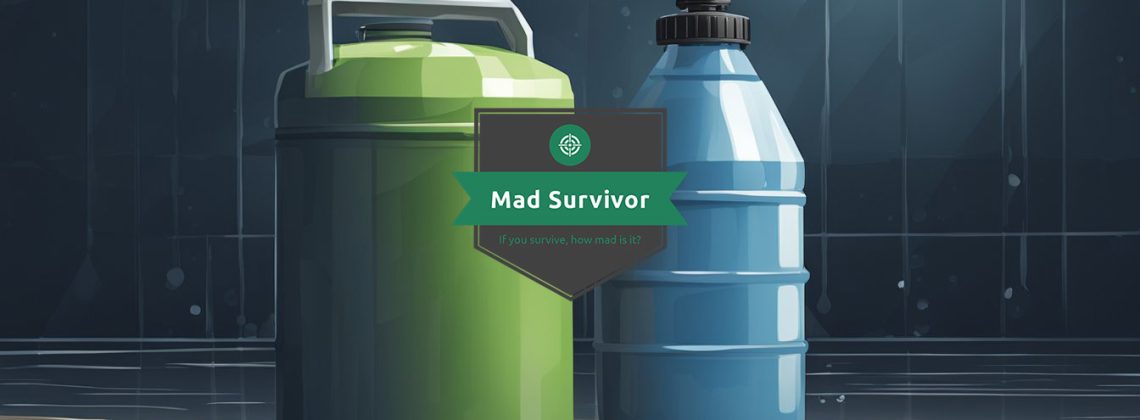
Storing water for the long haul isn’t just for those who wear tin foil hats and preach about the apocalypse. It’s actually a smart move for anyone who understands that emergencies can pop up at any time. You never know when a natural disaster might strike, the power might go out, or the water supply gets contaminated. By setting aside some water now, you’re giving yourself a little peace of mind.
When you’re getting your long term water storage together, think quality and quantity. You’ll want to start with clean, pure water, because that’ll give you the best shot at water that stays fresh over time. Choosing the right containers is also key. Heavy-duty, BPA-free containers or barrels are your best bet to keep your water safe and taste-free. Oh, and treat your water too – just to knock out any nasties that might want to take up residence.
Location matters as well. You don’t want to stash your water just anywhere. Find a cool, dark corner that stays between 50 and 70 degrees Fahrenheit, away from direct sunlight. Sunlight and warmth are like a party invitation for microorganisms, and you definitely don’t want them crashing your emergency water stash. So, do yourself a favor, follow these pointers, and you’ll have one less thing to worry about when life throws a curveball.
Understanding Long Term Water Storage
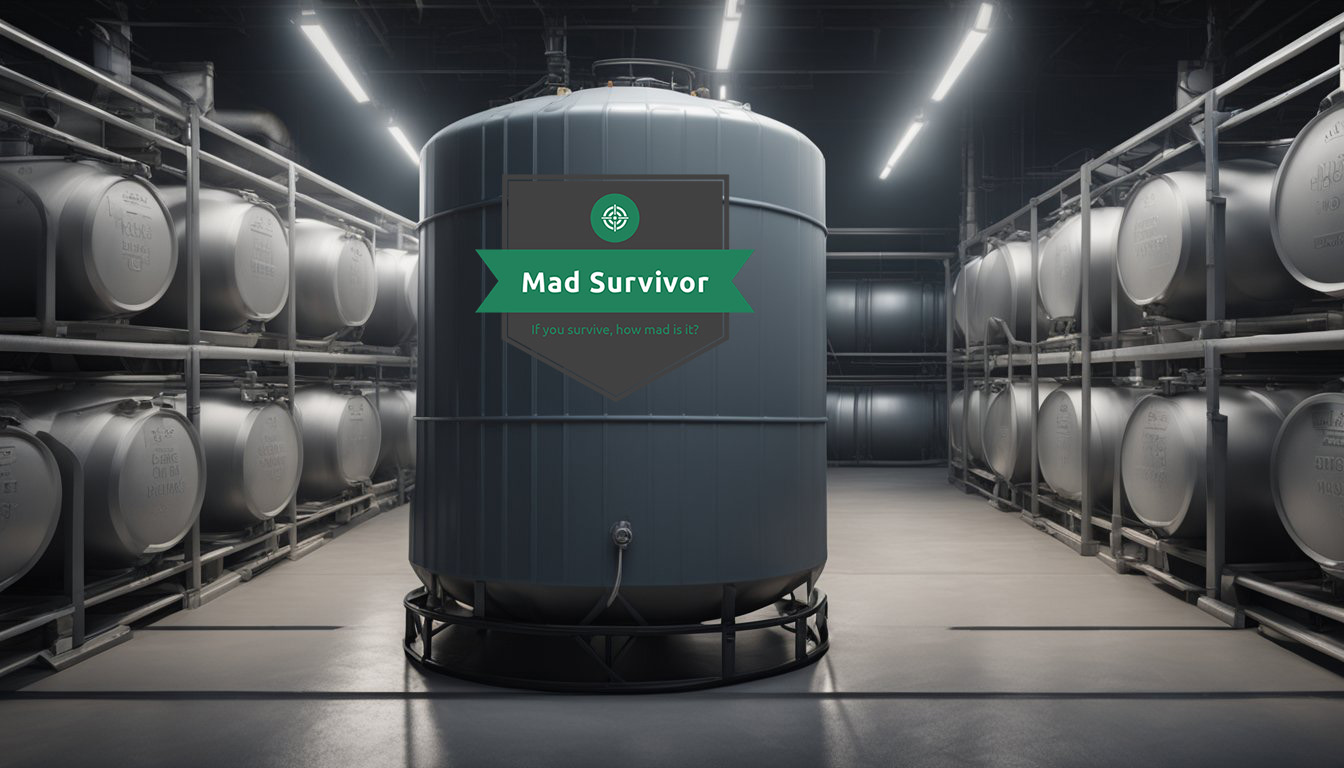
When considering how to store water for emergencies, you want to ensure your water remains pure and accessible. This involves understanding why water storage is crucial and knowing the elements that affect the lifespan of your stored water.
The Importance of Storing Water
You never know when a disaster might strike, leaving you without access to clean water. Having a long-term water supply means you’re prepared for situations like natural disasters or other disruptions to your regular water source. For your peace of mind, aim to store at least a two-week supply, with one gallon of water per person per day. That’s your hydration and sanitation covered.
Longevity Factors for Stored Water
Several factors come into play to keep your water safe over time:
- Purity: Start with water that’s clean; contamination can lead to health issues.
- Containers: Use sturdy, BPA-free containers designed for long-term storage. Think heavy-duty barrels rather than recycled milk jugs which can degrade and leak.
- Treatment: Adding a small amount of bleach can prevent microbial growth.
- Temperature: Store your water in a cool environment, ideally between 50 – 70°F to slow down any bacterial growth.
- Sunlight: Keep containers out of direct sunlight to prevent algae and bacteria proliferation.
- Rotation: Refresh your supply every six months to maintain freshness.
- Location: Avoid storing near harmful substances to prevent contamination via vapors.
Choosing the Right Water Containers
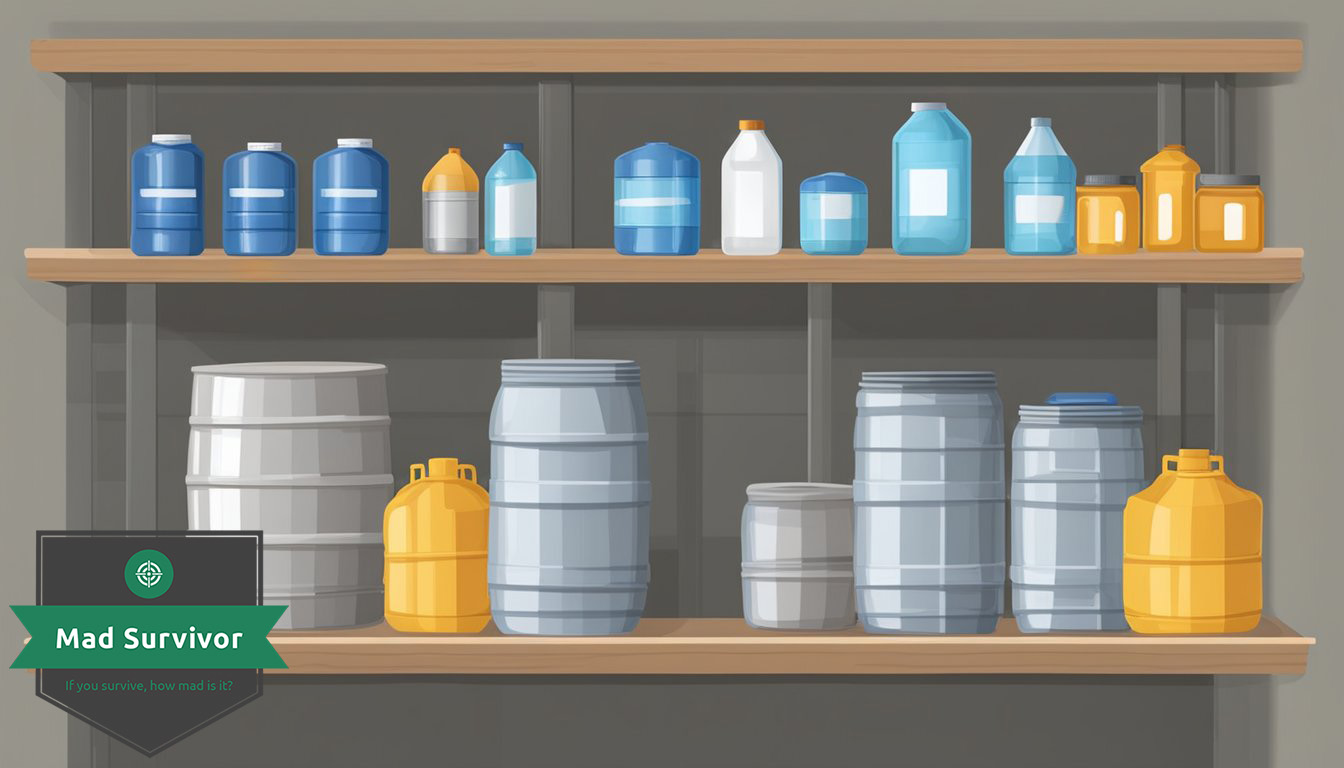
When it comes to long-term survival, picking suitable containers for your water storage is as crucial as the water itself. You want containers that are durable, safe for drinking water, and appropriate for the amount of water you’ll need.
Types of Containers Available
Available Options:
- Commercial Water Barrels: Specifically designed for water storage, these are among the best water storage containers.
- Food-Grade Plastic Bottles: Handy for smaller quantity storage, often used for short-term supplies.
- Glass Bottles: Ideal for those concerned about plastic contamination, but they’re heavy and fragile.
- Stainless Steel Containers: Durable and resistant to corrosion but costly.
Material Considerations for Containers
Material Pros & Cons:
- Plastic: Lightweight and affordable but ensure it’s BPA-free to prevent chemical leaching.
- Stainless Steel: Incredibly durable and safe from chemicals but not budget-friendly for everyone.
- Glass: Pure and non-permeable but impractical for large quantities due to weight and breakability.
Size and Scalability
Choosing the Right Size:
- Opt for large barrels (50-55 gallons) for long-term, large family storage.
- Consider stackable containers for saving space but verify stability.
Scalability Factor:
- Start small if necessary; you can always add more containers.
- Ensure you have a mix of sizes for portability in case of an emergency relocation.
Preparing Water for Storage

When you’re aiming to store water long term, it’s crucial to start with proper preparation to ensure your supply remains safe and drinkable. You’ve got to treat and contain water appropriately.
Water Treatment Methods
Before stashing away your H2O, you need to zap any lurking organisms that could spoil your supply. Here’s the skinny on getting your water clean:
- Boil: Nuking water at a rolling boil for at least one minute kills most beasties.
- Chemical Treatment: You can use unscented household bleach (5-6% sodium hypochlorite concentration). Use 8 drops per gallon if it’s clear, double it if it’s cloudy.
- UV Radiation: There’s tech out there that uses ultraviolet light to purify. Handy if you have it.
Filling Containers
Once your water’s treated, it’s time to lock it down in containers. Check these tips to fill ’em up right:
- Choose Wisely: Go for sealable, durable containers specifically labeled for water storage.
- Sterilize: Clean your containers with a bleach solution (one teaspoon of bleach per quart of water works) before use.
- Fill it Up: Leave a little room at the top to account for any expansion if freezing is a risk in your storage spot.
- Seal the Deal: Tighten those lids, but don’t Hulk out—just snug enough to keep contaminants out.
Remember, once you’ve got your water squared away, store it in a cool, shaded area and out of direct sunlight. Keep it away from harmful chemicals, like gasoline and pesticides, which can sneak into your supply and spoil the party.
Storing Your Water Safely
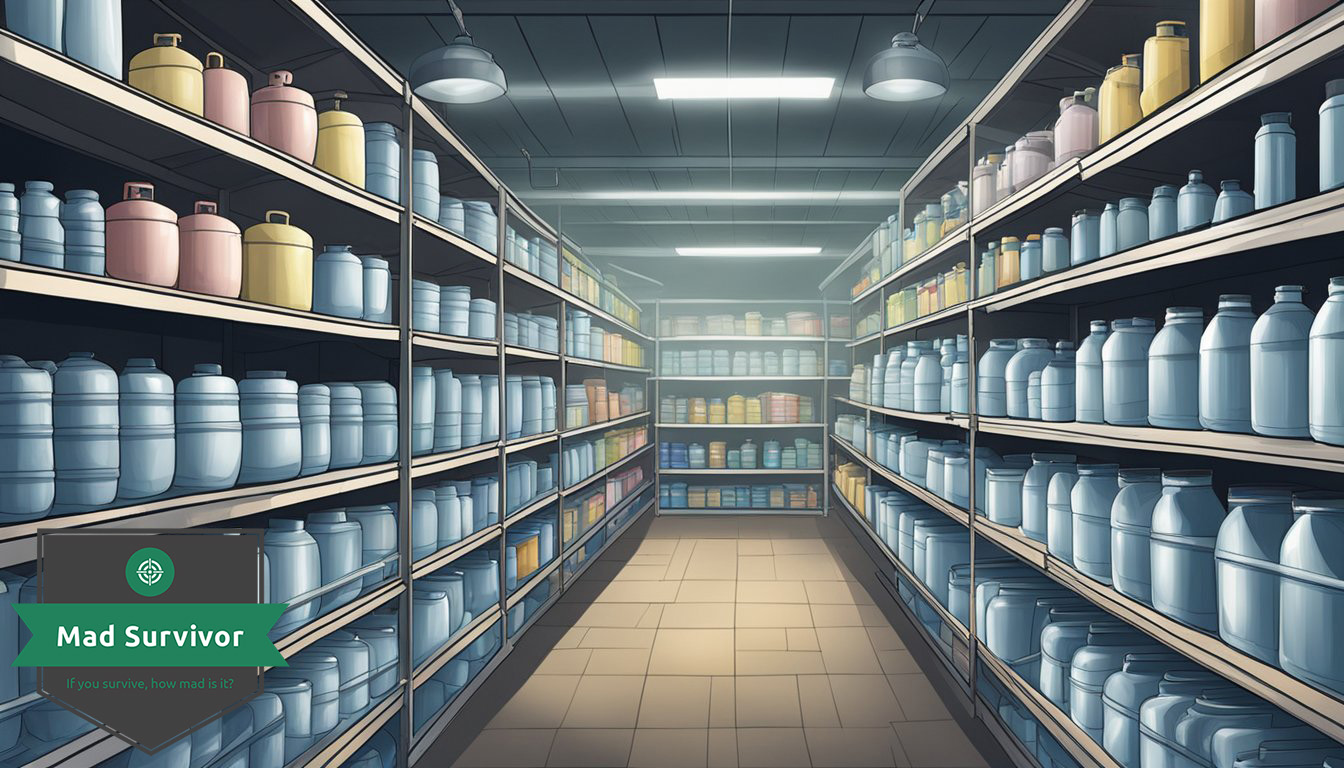
When thinking about long-term survival, ensuring your stored water remains safe and drinkable is paramount. Here’s how to nail down the basics of secure water storage.
Ideal Storage Conditions
Temperature: To prevent algae and bacteria growth, store your water in a cool and dark place, ideally between 50 and 70 degrees Fahrenheit.
Containers: Use food-grade storage containers, often made from polyethylene. Make sure they’re airtight and have not previously stored any toxic substances. Opaque containers are preferred to prevent light exposure.
Location: Keep your water containers off of the ground on pallets or shelves to avoid any potential contamination from the floor.
Maintaining Water Quality Over Time
Purification: Before sealing, ensure your water is properly treated. Use unscented household bleach (about 5 to 8 drops per gallon) if needed, and steer clear of containers that have had milk or fruit juice in them as they can harbor residues that promote bacterial growth.
Seals: Regularly check that the seals on your containers are intact. If you’re using screw caps, make sure they’re tightly closed to prevent contaminants from entering.
Inspections: Visually inspect your water supply every 6 to 12 months for any signs of contamination, like cloudiness or unfamiliar smells.
Rotation Schedule for Water
Tracking: Label each container with the date of storage. This will help in maintaining a rotation schedule.
Rotation: Replace your stored water every six months to a year, or follow the manufacturer’s expiration dates if you’re using commercially bottled water.
Usage: To make rotation easier, use the oldest stored water first for non-drinking purposes, such as watering plants or cleaning.
Water Access and Usage
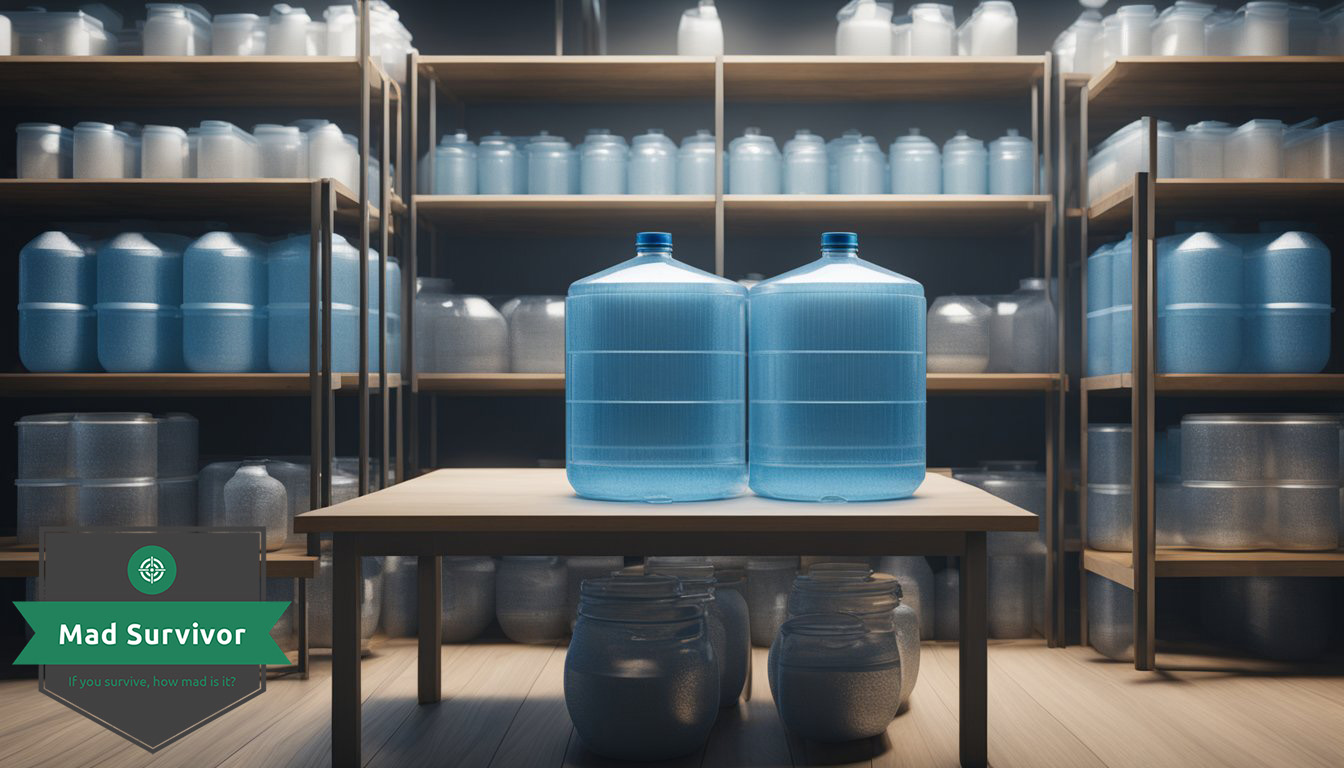
When planning for long-term survival, you’ve got to consider not just storing water but how you’ll get to it and use it when it counts.
Dispensing Stored Water
To get water out of your storage without contaminating the rest, invest in siphons or spigots. These can usually be attached to your storage containers, allowing you to pour out what you need without exposing the water to air or potential contaminants.
Using Stored Water in Emergencies
In emergencies, your stored water isn’t just for drinking. Remember you’ll need it for cooking and hygiene as well. Strictly ration your water, reserving at least half a gallon per person per day for drinking, and equally portion out the rest for cooking and staying clean.
Frequently Asked Questions
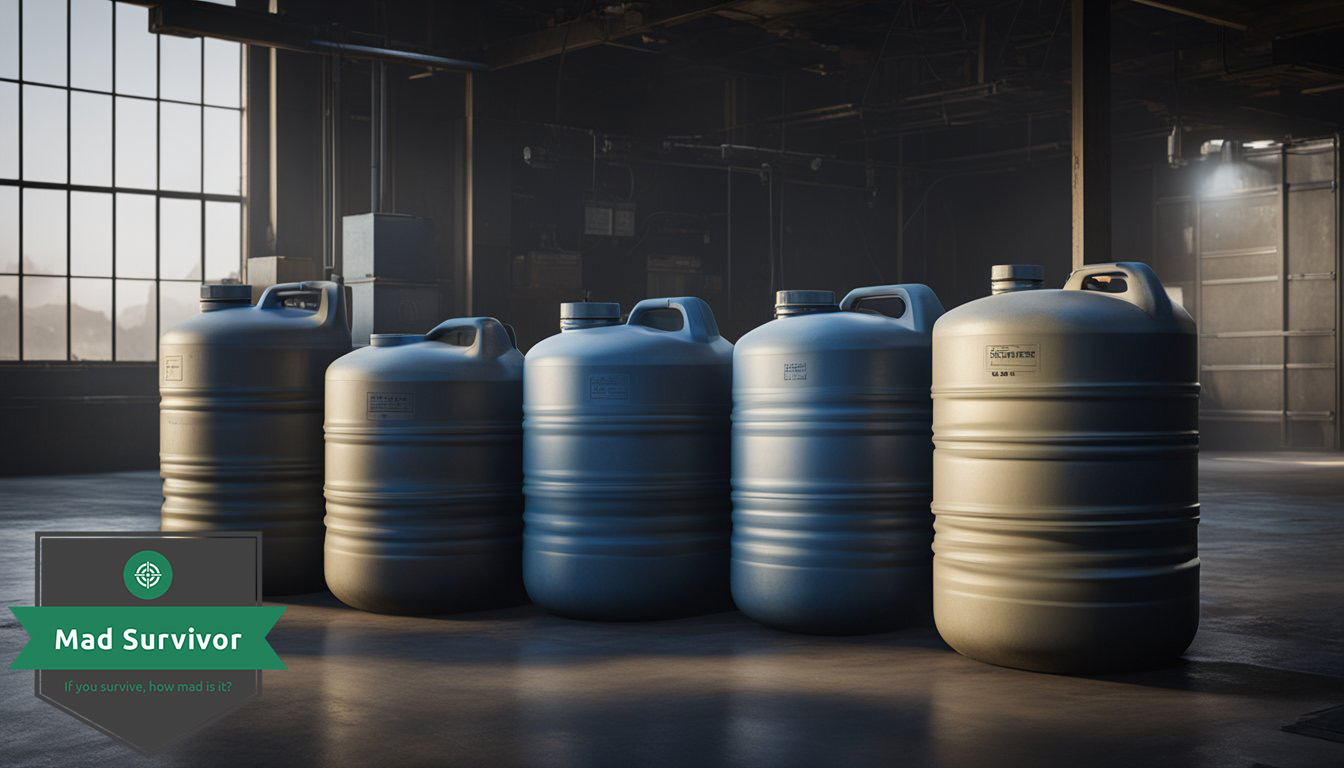
In this section, you’ll find practical tips and straightforward answers to your most common queries about long-term water storage.
What’s the best way to keep water safe to drink for years?
For long-term water safety, it’s crucial you store your water in a cool, dark place and use proper containers, like food-grade plastic or glass. Preventing exposure to sunlight and consistently cool temperatures help curb bacterial growth and contamination.
Are there any special containers recommended for long-term water storage?
Yes, you should use food-grade containers that are either stainless steel, glass, or plastic marked with the recycling codes #1, #2, or #4. Make sure your containers have not previously stored non-food substances to avoid contamination.
How do I use bleach to store water for emergency situations?
To disinfect water with bleach, add about one-eighth of a teaspoon (about 8 drops) of unscented, household chlorine bleach to one gallon of water. Stir it and let it stand for at least 30 minutes before use, ensuring the bleach is distributed evenly to kill any harmful organisms.
What should I know about storing tap water for extended periods?
When storing tap water, treat it with bleach as described above and seal it properly in clean, airtight containers. Replace the stored tap water every six months to ensure freshness and safety.
Can I store water indefinitely, or does it have an expiration date?
Water itself doesn’t expire, but the quality can deteriorate over time due to environmental factors and container materials. Regularly inspect your stored water and replace it at least once every six months for best quality.
What’s the longest term I can store drinking water without it going bad?
Typically, if stored correctly, water can remain safe to drink for up to two years. However, the best practice is to rotate your water supply every six months to maintain its safety and freshness.

Leave a Reply